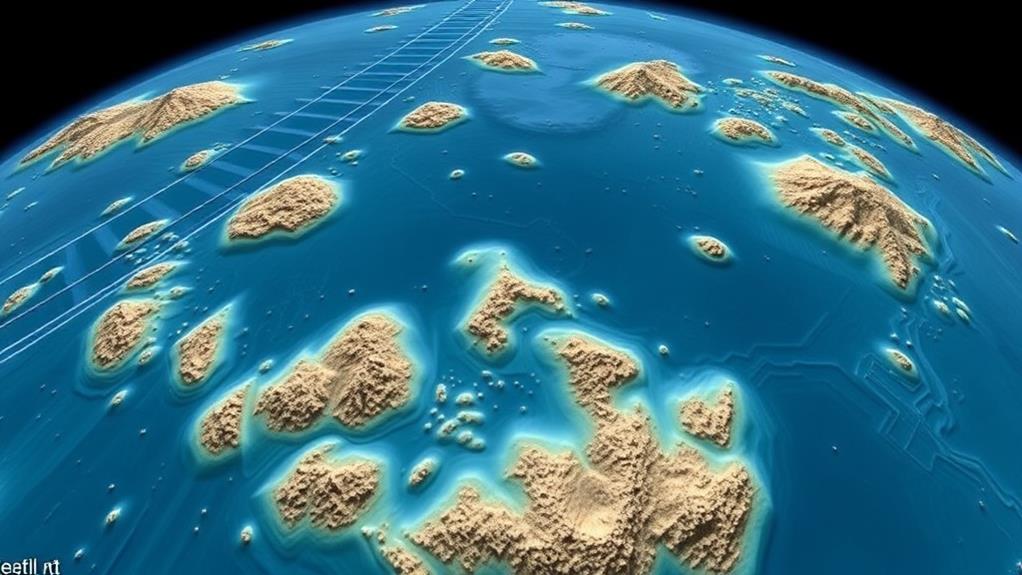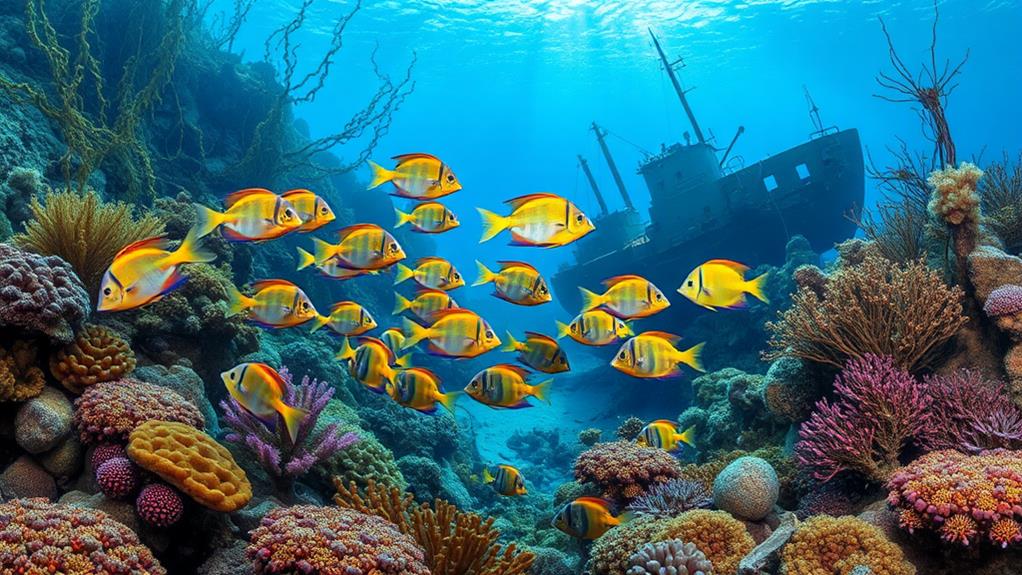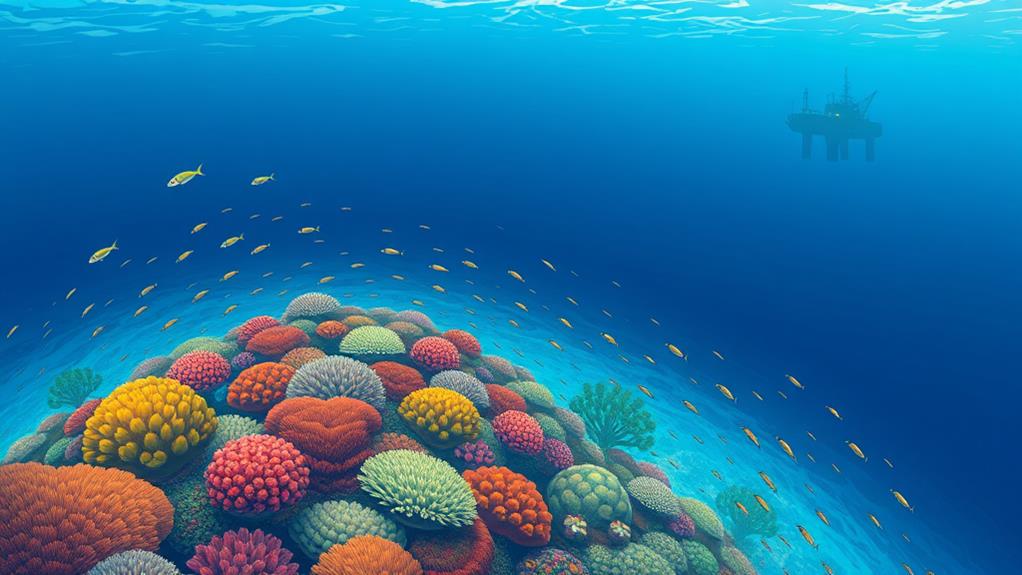The Benham Rise is a 13 million hectare underwater plateau off the eastern coast of the Philippines, characterized by complex seabed morphology.
This unique feature is home to the Apolaki Caldera, potentially the largest in the world, which highlights significant geological events.
The region is a critical nursery for economically important fish species and supports local fisheries.
It is also home to an incredible 200 documented fish species.
Ongoing research and conservation efforts are working to uncover the secrets of this underwater plateau and protect its resources for future generations.
Geographic and Geological Overview

The Philippine Rise is a submerged geological feature located east of Luzon, Philippines.
Benham Rise, a part of the Philippine Rise, is an underwater plateau that covers approximately 13 million hectares. It's situated 250 kilometers east of Dinapigue, Isabela. This vast underwater landscape rises over 2,000 meters from a depth of 5,000 meters to above 3,000 meters below sea level, with a diameter of 250 kilometers.
Benham Rise's geological formation is linked to mantle plume activity. This process has created five sequences of propagating rifts, which have shaped its unique underwater landscape.
One notable feature of Benham Rise is the Apolaki Caldera, potentially the largest caldera in the world. This massive geological structure showcases significant geological events in the area.
Hydrographic studies have revealed complex seabed morphology, providing crucial insights into the tectonic evolution and environmental dynamics of the Philippine Rise.
These studies have helped scientists understand the complex processes that have shaped Benham Rise's geological formation and continue to influence its environment today.
Expedition Discoveries and Findings
Scientific expeditions to Benham Rise have greatly expanded our knowledge of marine life in the region.
Over 200 fish species were documented in 2016, a significant increase from the 50 species recorded in 2014. The shallowest part of the seamount, Benham Bank, serves as a critical nursery for economically important fish species.
Advanced technology, including a remotely operated vehicle (ROV) and baited remote underwater video systems (BRUVS), enabled extensive documentation of marine life.
Diverse coral assemblages, sponges, and algae were also discovered in 2016, highlighting the region's rich biodiversity. These findings emphasize the need for conservation efforts to protect Benham Rise's marine resources.
The expedition's discoveries have greatly enhanced our understanding of the region's biodiversity, underscoring the importance of continued research and conservation of this unique ecosystem.
Ecological Importance and Significance

Benham Rise Ecosystem Supports Local Fisheries and Marine Biodiversity
The Benham Rise ecosystem plays a vital role in supporting local fisheries and marine biodiversity. This underwater plateau serves as a nursery for economically important fish species.
Rich Marine Life Maintains Biodiversity
Benham Rise is home to over 200 fish species, diverse corals, sponges, and algae. This rich marine life underscores the crucial role of the area in maintaining marine biodiversity.
Coral Assemblages Provide Critical Habitat
Coral assemblages in Benham Rise provide critical habitat for various marine species, emphasizing the ecological significance of these underwater ecosystems.
Biodiversity Maintains Ecological Balance
The region's biodiversity is vital for maintaining ecological balance and sustaining local communities that rely on its resources for their livelihoods.
Protecting Marine Resources Supports Sustainable Fisheries
Findings from expeditions have underscored the importance of protecting marine resources in the Benham Rise, which supports sustainable fisheries and conservation efforts.
Conservation Efforts and Strategies
Protecting the Benham Rise Ecosystem
Declaring Marine Protected Areas: Conservation efforts are crucial to protect the Benham Rise ecosystem. In May 2018, parts of the Philippine Rise were declared a marine protected area, restricting harmful activities like overfishing and mining. This move preserves the rich biodiversity of the area.
Strict Protection Zone: Within the Rise, a 500 square kilometer Strict Protection Zone has been established for scientific research, highlighting the ecological significance of the area.
Raising Awareness and Advocacy: Organizations like Oceana are actively raising awareness about the importance of conservation and advocating for sustainable use of its marine resources.
Ongoing Research and Exploration: Research expeditions have documented over 200 fish species and diverse coral assemblages. This emphasizes the need for continued exploration to inform conservation strategies.
Collaborative Conservation Efforts: Collaborative efforts among scientists and stakeholders are essential for developing effective policies and conservation strategies to protect the marine ecosystems of the Benham Rise.
Sovereignty and International Recognition

Sovereignty and International Recognition
The Philippines' claim to Benham Rise was confirmed by the United Nations in 2012, granting the country sovereign rights over the area under the United Nations Convention on the Law of the Sea (UNCLOS). This recognition is crucial, as it establishes the Philippines' exclusive rights to explore and exploit the region's resources.
Key Aspects of Sovereignty
The Philippine government successfully filed a claim with the UN Commission on Limits of Continental Shelf in 2009, establishing its rights to the extended continental shelf in the region.
The area is classified as part of the Philippines' extended continental shelf, which extends 200 nautical miles from the baselines. The Philippines has exclusive rights to explore and exploit the region's resources, including fisheries, oil, and gas.
Additionally, the Philippine Rise was designated as a protected food supply exclusive zone in 2017, with specific areas declared as Strict Protection Zones for scientific research, banning mining and oil exploration.
Emphasis on Sovereignty
The Philippines' emphasis on sovereignty over Benham Rise is critical, particularly amidst concerns over foreign activities, such as those from China, which have raised questions about navigation rights and potential resource exploitation in the area.
Scientific Research and Exploration
Unraveling the Secrets of Benham Rise
Beyond national boundaries, Benham Rise offers scientists a unique opportunity to explore its mysteries. This underwater plateau is a treasure trove of scientific research opportunities, particularly in the realm of biodiversity.
Biodiversity Hotspot
Benham Rise is home to a diverse range of marine life, with over 200 fish species documented in a 2016 joint expedition. This significant increase in known marine life was made possible by the use of advanced technologies, such as a remotely operated vehicle (ROV) provided by Oceana.
In comparison, only over 50 fish species were recorded in 2014.
Hydrographic Studies
Hydrographic studies have greatly enhanced our understanding of the seabed morphology and marine ecosystems of Benham Rise. Between 2014 and 2016, hydrographic studies were conducted in collaboration with the Chinese Academy of Sciences, providing valuable insights into the region's oceanography.
Renewable Energy Potential
The discovery of the Apolaki Caldera in 2019 has opened up new avenues for renewable energy generation through hydrothermal systems. This finding highlights the potential of Benham Rise to contribute to the global transition to renewable energy sources.
Ongoing Research
Ongoing scientific research is crucial to unlocking the secrets of Benham Rise. As scientists continue to explore this underwater ecosystem, they'll uncover more of its mysteries and potential applications.
Environmental Protection Initiatives

Protecting Benham Rise: A Philippine Government Initiative
The Philippine government has taken a significant step in preserving the ecological integrity of Benham Rise by designating parts of the area as a marine protected area in May 2018. This move aims to conserve the region's rich biodiversity and ensure ecological balance.
Restricting Harmful Activities
Human activities that harm the environment are restricted. The marine protected area prohibits activities such as overfishing and mining, which can disrupt the delicate balance of marine ecosystems.
Preserving Marine Life
A 3,000-square-kilometer area has been designated as a Special Fisheries Management Area. This designation protects marine life and ensures the long-term sustainability of local fisheries.
Strengthening Conservation Efforts
Stricter conservation policies are in place. The government has implemented these policies to combat illegal fishing practices and pollution from nearby urban areas.
Collaborative Conservation
Ongoing scientific research and collaborative efforts are essential. Government agencies, local communities, and international organizations work together to effectively enforce environmental protection initiatives and conservation strategies in the Philippine Rise.
Strategic and Geopolitical Importance
Benham Rise's unique geography makes it a critical strategic maritime zone. Control over the Luzon Strait is vital for naval movements in regional conflicts because it serves as a strategic chokepoint, impacting access between the South China Sea and the Western Pacific Ocean.
The Philippine government actively asserts its sovereignty over the Benham Rise, amid concerns regarding potential geopolitical tensions with China. China views the region as part of its Island Chain Strategy, with control over the Benham Rise being key to countering U.S. naval presence and influencing regional security.
Ongoing diplomatic efforts by the Philippines are essential to address issues related to sovereignty, resource exploration, and international interests in the Benham Rise region.
The region's significance in regional security dynamics is particularly important in the context of the South China Sea.
Natural Resource Management and Sustainability

The Benham Rise, an underwater plateau rich in natural resources, presents opportunities for energy and industrial development, but also poses significant environmental and sustainability challenges. Sea level rise due to climate change is a potential threat to the stability of the Benham Rise, as it could lead to increased flooding and erosion of the plateau. Additionally, the extraction of natural resources such as oil and gas could have negative impacts on the marine ecosystem and biodiversity of the area. Consequently, careful and sustainable management of the Benham Rise is essential to ensure that both its economic potential and environmental integrity are preserved for future generations.
To ensure sustainable development, resource exploration and exploitation must align with environmental protection and conservation efforts.
The Philippine government emphasizes the importance of enforcing sovereign rights under the United Nations Convention on the Law of the Sea (UNCLOS) to achieve sustainable management and preservation of the Benham Rise's natural resources.
Designating parts of the Philippine Rise as a marine protected area is a key conservation initiative to sustainably manage and preserve its rich biodiversity.
Key considerations for natural resource management and sustainability in the Benham Rise include:
1. Sustainable resource exploration: Ensuring that resource exploration and exploitation don't harm the environment or deplete natural resources is crucial. This can be achieved by implementing environmental impact assessments and monitoring systems to detect potential harm.
2. Environmental protection: Preventing pollution, habitat destruction, and other environmental degradation requires implementing measures such as waste management systems and habitat restoration programs.
3. Conservation initiatives: Establishing and maintaining marine protected areas, such as no-take zones and wildlife reserves, helps preserve the Benham Rise's ecological significance.
4. UNCLOS compliance: Ensuring that all resource management and sustainability efforts comply with UNCLOS regulations is essential to maintain the Philippine government's sovereign rights over the Benham Rise.
Are there any potential resources to be explored at Mount Hibok-Hibok similar to the Benham Rise?
The geological features of mount Hibok-Hibok offer potential resources waiting to be explored, much like the Benham Rise. With its unique topography and diverse ecosystem, Mount Hibok-Hibok presents opportunities for discovering valuable resources that could contribute to scientific research and economic development.
Future Research and Development Directions
Unlocking the Benham Rise Region's Natural Resources
Future research in the Benham Rise region will involve multidisciplinary approaches to harness its vast natural resources. These resources include untapped natural gas and heavy metals, which hold significant economic potential for the Philippines.
For instance, the Apolaki Caldera, potentially the world's largest, will be explored for its geothermal energy potential and development of hydrothermal systems for renewable energy generation.
Understanding Ecological Significance
Ongoing biodiversity studies are crucial for understanding the ecological significance of the marine life in Benham Rise. The region supports various economically important fish species and diverse coral ecosystems.
These studies will help identify conservation strategies and climate change impacts on the region's ecosystems.
International Collaboration and Research Agreements
International collaboration with scientists and marine research institutes will enhance the capacity for comprehensive studies. These studies will focus on climate change impacts and marine conservation strategies in the region.
Implementing Marine Scientific Research agreements will facilitate the exploration of ocean currents and other environmental factors. This will ensure that research activities adhere to the "Trust but Verify" principle, protecting Philippine sovereignty.
Frequently Asked Questions
What Are the Resources Found in Benham Rise?
Benham Rise is a submerged plateau with diverse marine life.
It features unusual coral formations and economically important fish species, making it a potential sustainable fishing ground.
The region also has geological features like the Apolaki Caldera, which could have hydrothermal systems.
Mineral deposits of natural gas, heavy metals, and manganese are present and await extraction.
Why Is the Benham Rise Important?
The Benham Rise is important because of its multifaceted significance.
As a biodiversity hotspot, it supports a vast array of marine life, including coral reefs, fish, and other species. This makes it crucial for environmental conservation, as preserving the area's ecosystem helps maintain the delicate balance of marine life.
Geopolitically, the Benham Rise has substantial implications, as sovereign rights over the area grant exclusive access to natural resources, such as oil, gas, and minerals. This highlights the region's strategic importance for countries with claims to the area.
Culturally, the Benham Rise is significant due to its rich heritage, with archaeological findings and historical artifacts scattered throughout the region.
Sustainable development is also possible, as the area's natural resources can be harnessed to support local communities while minimizing environmental impact.
Balancing economic potential with marine conservation efforts is vital to mitigate climate change and ensure a healthy ecosystem. This requires careful management of the region's resources to prevent overexploitation and preserve the area's natural beauty for future generations.
What Is the Research of Benham Rise?
Benham Rise is a vital underwater plateau being extensively researched by scientists. They're studying its marine biodiversity, which includes a wide variety of species such as corals, fish, and other organisms.
To understand its ecological significance, researchers are also examining geological features, like underwater mountains and valleys, and ocean currents, which affect the plateau's climate and ecosystems.
Indigenous rights and environmental impact are also being examined. Scientists are looking into how the plateau's natural resources are being used by local communities and how human activities are affecting the environment.
Conservation efforts are being developed to mitigate the impact of climate change, which is altering the plateau's ecosystems and affecting the species that live there.
Advanced technology is being used to collect data. For example, the 2016 Oceana-led mission employed autonomous underwater vehicles and remote-operated vehicles to explore the plateau.
Hydrographic studies with international partners are shedding light on seabed morphology and ecosystems. These studies are creating detailed maps of the plateau's seafloor and identifying areas of high conservation value.
Is Benham Rise a Plateau?
Benham Rise is a submerged volcanic plateau. This unique geological feature is characterized by depths ranging from 2,000 to 5,000 meters.
Within the plateau, Benham Bank rises to more than 3,000 meters below sea level, making it a notable feature of the underwater landscape.
As a result, Benham Rise is a hotspot for marine biodiversity, supporting ecologically significant species and coral assemblages.